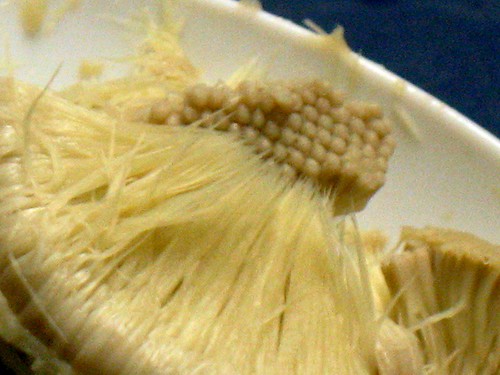I adore artichokes, but they are very expensive - and pretty scarce - in the UK. The first time I visited Spain, I was stunned to discover how cheap they were, there. Where our 'mixed vegetables' packs consist of peas, corn, carrots and green beans, theirs include artichokes. Alcachofa was one of the first Spanish words I mastered.
If you've never tasted an artichoke, let me advise you to avoid the canned artichoke hearts. They are sort of pickled, and nowhere near as nice as fresh ones. The fresh ones taste a little asparagus-ish.
Many people I know take one look at artichokes and say "Fugeddit!" I was one such. I had never eaten a fresh one (I wouldn't have known where to start to cook one), and the canned ones made me go "Meh." But in 1990, we went to stay with an old army buddy of John's in Pretoria, and his girlfriend cooked up artichokes for us one day. I was terribly impressed, until she told me how very, very simple it was. I was absolutely smitten with them, and they are way up there among my favourite summer veg.
My sister in law in the US knew about this love of mine. She also knew how pricey they are in the UK. and, when I was due to visit her this time last year, decided she would serve some as a treat for me, so she consulted her recipe book and, within minutes had decided that it was just far too much faff.
Perhaps you have a recipe book like that: chop the points off all the leaves, slice the artichoke in half vertically. Snap the stem off. Stand on your head and whistle Dixie.
Just no.
For me, the best and simplest way to cook an artichoke is as follows (and the only tricky part is finding a large enough saucepan!):
Rinse the artichokes thoroughly under running water, or in a basin of salty water. If you're going the running water route, remember to hold them right way up, as you would a flower (because that's what it is, after all), so that the water can reach down between the petals. If you're using a basin of salty water, you want to sort slosh them about quite vigorously in the water.
Bung the artichokes into a saucepan and then top it up with cold water enough to cover the vegetables. You can add a pinch of salt for good measure, if you like.
Bring the water to the boil and then reduce the heat slightly to keep it at a simmer.
Keep simmering this way for about 20-25 minutes. Test whether the artichoke is ready by trying to pull off a petal. If it comes away fairly easily, it's done.
Remove from the water and plop onto a plate and eat the wretched thing. If you fancy, you can eat it with mayo or butter with or without lemon and/or garlic added.
So now I hear you wail, "Yeah, but how do I eat it???"
Like this:
Tear off one of the outside leaves. It will have a small, soft heel where it was attached to the stem. Bite of that heel and throw bin throw away the rest of the leaf. You can dip the heel into one of the things I mentioned before if you like. I don't think it's necessary, quite frankly.
 |
| Remove the hairy bit... |
In the centre of the flower are all the pistils or stamens or whichever they are. Scoop those out with a spoon and throw them away. Now relish the best part of all: the heart. Oh bliss!!!
They make a great starter, by the way. One per person.
There are all sorts of other recipes out there for things to do with artichokes. My recommendation is to start with this one. The cooking process is about the same as for a mealie/ear of corn, and the testing for readiness is pretty much the same, too.


No comments:
Post a Comment